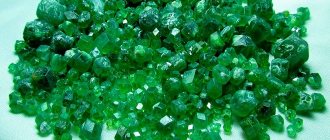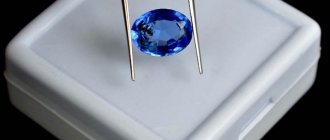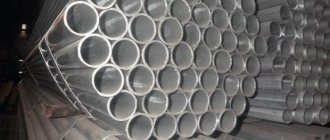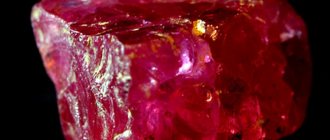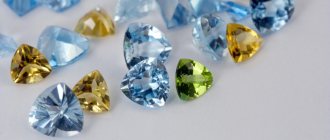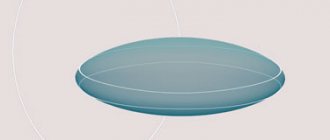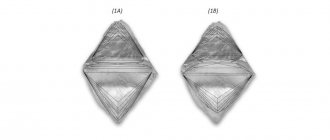Many scientists have sought to grow an artificial diamond ever since the theory arose that it was possible. Nowadays, the business of creating synthetic stones is very popular, since this is the only opportunity to satisfy the need for this mineral. In nature, it is found to be very imperfect, and its use in industry and electronics is unprofitable. But, thanks to the work of the great minds of the world, the solution was found in the form of laboratory crystals. We will talk about them.
Laboratory crystals: fake or full replacement
Calling synthetic diamonds a copy is incorrect. Rather, it is the same mineral produced in different ways. It's worth noting that the only differences between them is the way they appear. In one case, stones are born in nature, in the other, people have a hand in their creation.
An artificial stone produced in a laboratory acquires all the properties of a “real” stone:
- strength;
- structure;
- shine;
- refractive index;
- specific gravity;
- thermal conductivity;
- resistance.
But there is one difference between artificial diamonds - the complete absence of defects. This makes them an ideal material for industrial and jewelry purposes.
It is curious that only 20% of diamonds mined in nature can be used to create jewelry. Other stones have microcracks, inclusions and clouding. When using high-quality technologies, it is difficult to distinguish a natural mineral from an artificial one, even with laboratory equipment.
Where are synthetic diamonds used?
Artificial diamond is widely used by jewelry factories to make luxurious jewelry that not only looks beautiful, but is also very affordable. Products with fake stones look no worse and wear well.
Also, growing artificial diamonds is an integral part of modern industry. They are used to produce heavy-duty tools: grinding wheels, diamond saws, polishing discs, chisels, drills, scalpels, knives, various cutters and tweezers. Machinery and equipment made from diamond material make it possible to process the most durable alloys and raw materials. In addition, diamond ensures maximum precision in machines and instruments.
Alternative names in science and common people
In the scientific world, synthetic diamonds are named after the technology involved in their production. There are HPHT diamonds, which means created under high pressure and temperature. And CDV diamonds stand for chemical vapor deposition. We will tell you about the technologies themselves further.
But artificial diamonds are not always its complete copy. There are such types as cubic zirconia, moissanite, rhinestone, ferroelectric, rutile, fabulite and cerussite. Zirconium dioxide is the most common “fake” and has nothing in common with a real diamond.
Ignorant people call an artificial diamond a cubic zirconia, which is a big mistake. Of course, it perfectly imitates diamond due to its strength and refraction. Some experts cannot “by eye” distinguish it from the original stone. Therefore, they are widely used in the jewelry industry.
Diamond is the hardest mineral in the world
First of all, what we see in a jewelry store is a diamond. A diamond is a diamond that has undergone special pre-treatment by jewelers. From a chemical point of view, it is carbon with a cubic shape and crystal structure. Interestingly, carbon, depending on how the structure is built, can appear in the form of many substances that have different properties and uses.
Artificial diamonds
For example, everyone knows that the world is now switching to nanotechnology. Nanotechnologies are technologies whose essence is based on very small objects—thousandths of a micron. One of such objects are nanotubes. So, the smallest nanotubes, namely those with the smallest diameter, are also a form of carbon. The fact is that one atom of a substance can combine with five others, which already represents a compact structure. Among atoms that have such capabilities, it has the smallest mass and, accordingly, the radius of the atom.
If carbon atoms combine to form something similar to a soccer ball, they are called fullerenes. Fullerenes and nanotubes, as well as a monolayer of carbon - graphene, for which the Nobel Prize was recently awarded, will most likely be very widely used in technology in the future. They are interesting for their ultra-strong properties, as well as their conductivity, low resistance and size. The greatest value of nanotubes is to act as both conductors and semiconductors, depending on how the atoms are oriented to each other. This is the future of electronics.
Until now, scientists have not come to a clear conclusion about where diamonds come from. The main version says that crystals form deep in the Earth (more than 200 kilometers) under high pressure and enormous temperature. And then the magma throws them to the surface. There is also a version that the diamond is an extraterrestrial structure and flies to Earth along with meteorites. Another version also speaks of a cosmic origin: supposedly diamonds are formed when a meteorite falls, when high pressure is created.
The stones are very rare and beautiful. They are valued not only for their beauty, but also for the fact that they have unique properties:
- Diamond has the highest hardness among minerals;
- its melting point reaches 4000 degrees;
- thermal conductivity is the highest among all known solids;
- it belongs to dielectrics;
- has a unique refraction of light, under the influence of various rays it can begin to glow;
- does not dissolve in acid.
Journey into the past
Let's talk about how many years have passed since the hypothesis appeared that it was possible to obtain synthetic diamonds. For the first time, people started talking about this in 1797, when it was discovered that the stone consists entirely of carbon. But the idea was realized only in 1926, but this cannot be called a complete success. The resulting sample was far from the original, but became the starting point for research.
It was only in 1941 that General Electrics became interested in the technology. Their plan was to heat carbon to 3000 degrees under 5 hPa pressure. But production had to be stopped due to World War II. It was possible to return to research 10 years later.
A high-quality artificial diamond suitable for mass production was obtained only in 1954. But its size was so small that it was impossible to use it in the jewelry industry. Their business expanded into industry. The problem was solved in 1970, but even then the stones did not reach more than 1 carat.
Today, everything has changed and really large stones can be grown in laboratories. The maximum size of an artificial diamond listed in the Guinness Book of Records is 34 carats.
Color range of laboratory stones
Many people are interested in what shades lab-grown diamonds take. Today, scientists are able to “paint” synthetic pebbles in two colors: yellow and blue. But colorless diamonds are the most popular, although their creation requires more time and effort.
It is difficult to obtain transparent artificial diamonds because it is necessary to constantly ensure that the composition does not contain boron or nitrogen. Stones created with such efforts are treated with the most reverence and even small-sized samples of 1 carat are valued.
Blue synthetic diamonds are produced by adding bromine to carbon. Their shades vary: from deep blue to pale blue. Nitrogen is used to produce yellow diamonds. Then the color ranges from acidic lemon to fiery orange. To obtain black stones in the laboratory, nickel is needed.
Areas of application and opportunities
About 80% of created diamonds are used in industry and other areas of human life. For example, the production of bearings, tips for drills. Small pebbles can be used to make diamond chips and powder, which are used to coat knives or grinding tools.
Synthetic diamond plays an important role in electronics. They are used to create needles and layers in microcircuits and counters to maintain thermal conductivity and resistance. And this is only an approximate market where high-quality artificial stones can be sold.
For the production of CVD diamonds, the most important role is played by high-tech areas. They are necessary to create mobile phones. They are used to produce laser beams used in medicine: they are used to treat many deadly diseases. Therefore, the role of synthetic stones is enormous.
How did synthetic diamonds originate?
The need to create synthetic stone arose a long time ago. But in practice it was implemented only in the 20th century. Until this time, scientists could not come up with a technology for making diamonds, although they were able to establish that they are related to ordinary carbon. And a few decades later, the first synthetic diamond was created, which was obtained from graphite under the influence of high temperature and pressure through a phase transition. It was from this moment that the production of artificial diamonds began, which today are used in many elements of various equipment and tools.
Proven technologies and systems of the future
We'll tell you how to grow a diamond in the laboratory. A modern plant for their production uses two technologies. The first in popularity and occurrence is HPHT. It is based on heating carbon under high pressure. Its main advantage is the relatively low cost of the resulting stones.
How diamonds are made using the CVD method can be understood if you imagine a gas chamber. Inside is hydrocarbon gas, deposited on a silicon wafer by heating or using microwave radiation. As a result of the reaction, a plate 2-3 mm thick is obtained. Therefore, its main field of application is optics and electronics.
In some laboratories that grow synthetic stones, the “explosive” technology for producing diamond chips is common. It is based on the fact that an explosion creates high pressure and releases a lot of heat. The main thing is to quickly lower the camera into water to prevent the diamond from turning into graphite.
The problem with the “explosive technique” is that the precious chips are inside the graphite. It must be washed out by boiling in nitric acid for 24 hours at a temperature of 250 degrees.
Modern scientists are trying to obtain diamonds using ultrasonic cavitation, but this technology is still in testing mode and does not always give the expected result. If you are interested in trying to create a gemstone yourself, then read the article “How to make a diamond at home.”
Synthetic Diamonds 2021
01/10/2021 Gemology 1903
Alexey Lagutenkov
Website: Go
Independent expert gemologist. Academic titles: GG GIA (Chartered Gemologist, Gemological Institute of America), AJP GIA (Accredited Jewelry Professional of the Gemological Institute of America), MBA Kingston University UK (Master of Business Administration from Kingston University UK).
Author of the best-selling book "Gemstones".
Other expert publications:
- Evaluation of colored jewelry stones. Introduction to the "World of Color" from GemGuide
- Field test of Diamond Inspectors
- How to evaluate a gem or a game without rules
- Let's talk about the new GOST for diamonds
- Sapphirite Madness
The COVID epidemic has intricately disrupted the economy of the entire world, and the diamond business is no exception. Manufacturers and traders from the diamond mining industry to retail have felt the full joy of isolation and economic downturn. Over the nine months of 2021, ALROSA alone reduced diamond production by 23% [1] . Despite the fact that the pandemic has not gone away and frightening talk of a second wave is trying to finish off the remaining industries, the world is gradually beginning to adapt to life in new conditions.
The jewelry business, which completely stopped in March-May 2021, is trying to find new directions. announced in September the total sales of rough and polished diamond products in the amount of $336 million [2] . And Moscow even managed to host the autumn “Junvex”, at which buyers who had been stuck in self-isolation surprised retailers with good demand. Probably, the second wave of the epidemic will cancel all other exhibitions until the end of the year, but it is nice to know the fact that the jewelry industry has not died completely.
However, the virus did not always cause harm. India's quarantine closure led to a shortage of cut diamonds, which is why, after a prolonged decline, prices for diamond products began to carefully feel their way towards stabilization.
Meanwhile, the technology for producing synthetic diamonds has not stood still this year, and the main conversation in this article will be about synthetics, which has now received the official name LGD - an abbreviation for Laboratory Grown Diamond (translated from English as “diamond or diamond grown in laboratory"). Richard Drucker, owner and editor of the world-famous Gemguide magazine, in his recent article [3] recalls that, despite the presence of the word “laboratory” in the name of the stones, the conversation has long been not about individual installations and enthusiastic scientists, but about huge factories and industrial installations.
2020 brought even greater technological improvements to the LGD field and, accordingly, a drop in prices. Mr. Drucker mentions that five years ago no one could have even imagined such an explosive growth in interest in synthetics! The postulates about “conflict-free” and “ecologically clean” stones that justify synthetics no longer concern anyone, and, in principle, are of no interest to anyone anymore. The main question is the price! Half-carat with DF color and VS clarity fell in price by almost half in 2021: from $1050–2250 in the fourth quarter of 2021 to $600–1450 per carat in the third quarter of 2020. De Beers went even further. Having invested heavily in factories for the production of LGD, they are promoting the already famous diamond brand Lighbox. White, pink and blue diamonds weighing up to one carat in De Beers jewelry are now valued at $800 per carat.
Synthetic dealers around the world claim that synthetic diamonds are currently bringing in more profits and are selling much better than natural diamonds. Some major retailers in the US are even talking about "growth" in their synthetics business. The main question that worries wholesalers now is to what extent will prices for LGD fall, where is the “bottom”? There is an opinion that $800 per carat from De Beers is that “magic price,” at least for stones whose weight does not exceed 1 carat. The cost of producing larger diamonds continues to be high, and a reduction is unlikely to be expected. Also, you should not hope for a profitable purchase in the near future of large LGDs weighing 5 carats or more.
Improving LGD production technologies has another side. Distinguishing a natural diamond from a synthesized one is becoming increasingly problematic. Bill Hofer's article "The Colorless Nightmare" [4] published in the April Gemguide offers valuable advice to all American diamond appraisers. The author recommends adding to each evaluation report a page with literally the following content:
“To confirm that the diamond in question is natural or lab-created requires extensive laboratory testing, which can be expensive and therefore beyond the scope of this expert opinion. The client may, for an additional fee, send the appraisal item to a reputable gemological laboratory for more advanced testing. The diamonds examined and described in this report were tested by methods available to this gemologist, such as fluorescence, screening instruments and magnification. Supporting documentation, where available, was taken into account. Therefore, all diamonds in the item examined are assumed to be of natural origin, unless otherwise stated in this grading report.”
This is not a new statement, but until recently it was assumed that at least large Type II nitrogen-free diamonds, weighing from 0.3 carats, could always be recognized by any pocket screener. It turns out that not everyone and not always.
In January 2021, well-known to Russian and international audiences, Ph.D. V.G. Vince posted an interesting statement on his Facebook page [5] :
“Here (meaning in the photo in the post. – Editor’s note) NRHT grown diamonds, as they say now, are from our friends and partners from the PRC. They produce a lot of such stones (DE / 2.5–3.0 ct.). Even a lot - hundreds of thousands of carats per year. Almost all products are purchased by our other friends and partners from India. All this is cut and sold as natural stones. Modern gemology, incl. using methods of primitive absorption and luminescence spectroscopy, apparently, is not able to cope with the identification of diamonds. I think fundamental changes are needed, namely a transition from traditional gemological tests... to fundamentally new ones - thermoaction methods based on the study of charge carrier capture centers. The set of these defects, in contrast to the set of absorption and radiative recombination centers, is individual for diamonds of different types and different genesis, and is also sensitive to post-growth influences. At one time, this is exactly how we proposed to GIA to test HPHT treated stones. If the transition to TA methods does not take place, then all that remains is to lament “let’s restore trust in natural diamonds.” And some people listen and eat.”
Information: Viktor Genrikhovich Vince is a Doctor of Physical and Mathematical Sciences, a famous Russian scientist, researcher and entrepreneur from Novosibirsk. His research and production and HiTechDiam have been producing, researching the properties and high-tech applications of grown diamond single crystals for a long time, and scientific works devoted to the synthesis of diamonds and their features are well known and highly appreciated throughout the world.
Victor Genrikhovich is an extremely busy person, but our editors were lucky and we were able to interview him, in which we asked him to comment and explain the principles of the thermoaction method in a way that would be understandable to a wide range of readers.
A.L.: Viktor Genrikhovich, I will not hide the fact that your post on FB about thermal promotional identification methods was of interest to many. You said that it is now difficult to examine a stone specifically for jewelry purposes in order to distinguish a natural diamond from a grown one. My question is: aren't all LGDs Type II? Or is it not so simple?
V.G. Vince: Exactly, it's not that simple. Once I personally almost suffered from this “simplicity”. Three years ago, an Indian company sent me samples of CVD synthetic diamonds, wondering if they could be decolorized in any way? The fact is that CVD diamond single crystals obtained at high growth rates are brown or gray-brown in color. And thus, from the point of view of jewelry, it is an unattractive color that sharply reduces the value of a possible diamond. As a result, the question of whether such stones can be discolored is very important for the manufacturer. Without thinking twice, my Indian partners sent me a parcel by regular mail, containing 15 or even more samples, weighing half a carat each. Of course, customs is not asleep, and the parcel was immediately seized. They decided it was illegal import of natural diamonds across the border. I had to prove, write letters, explain to competent people that this is not so. Let's digress a little. Novosibirsk customs, so you understand, are people from Akademgorodok, with a very good education, and there is no doubt about their competence. But a customs expert, regardless of which city in Russia he is located in, uses in his work only standard gemological tests developed at a time when only scientists, and even not everyone, had heard of CVD.
Based on the available knowledge, customs makes a completely logical conclusion that they are looking at not quite ordinary, but quite natural stones. This example is quite typical and well reflects the modern, current problem with LGD recognition.
If the examination had used the so-called “thermal-stimulated luminescence” method, based on studying the capture center, then customs would not have had any questions at all. It would be immediately obvious that these are diamonds grown in the laboratory using the gas-phase synthesis method (i.e., the CVD method), which are characterized by a completely special set of crystal lattice defects, detected precisely with the help of thermally stimulated luminescence.
It’s probably time to explain what the conversation is all about. Imagine placing a diamond in liquid nitrogen and exposing it to ultraviolet or x-ray radiation for a long time. If you subsequently begin to heat such a stone, then at certain temperatures it will begin to “flare up” and give off light. This happens because the diamond structure “stores light sums,” i.e. captures electrons excited by radiation into so-called “traps” (in scientific terminology, “charge carrier capture centers”), and when heated, these same electrons are thermally activated, i.e. receive energy from the lattice, “jump” out of their traps and fall into recombination centers, which is why light is emitted. For diamonds of different types and genesis, the set of capture centers and, accordingly, the temperatures at which they are emptied is very characteristic.
In 2015, I gave a lecture at Gokhran on diamond identification, including a proposal to use thermally stimulated luminescence as one of the possible methods for identifying CVD diamonds
There is an earlier story, from the early 2000s, when a large number of natural refined diamonds began to enter the market. Brown stones without nitrogen content after upgrading using the HPHT annealing method become colorless, and if they contain nitrogen, then yellow-green. Gemological laboratories at that time immediately started talking about “new diamonds with unique colors”, since identifying refinement was then very difficult. Even then we suggested: let’s move away from these “let’s look through a microscope under one light, then under another, and try to draw some conclusions...”. Instead, it was proposed to use thermal activation methods, since with such an analysis the set of peaks on the graph will be individual and very indicative specifically for refined stones. There was a special seminar on this topic at the GIA central office, in which the head of the GIA research department and his deputy, now the head of this division, participated. They conferred and said, “Yes, this looks like it could work!” Research began, but for reasons unknown to me, it was quickly curtailed. Most likely, the reason is that in Novosibirsk, when we work, we are used to assembling the equipment we need, like a construction set, with our own hands. Serious companies use only standard factory configurations, and it is simply unthinkable for an employee to independently make any changes to this equipment. It seems that in the configurations in which the researchers had the necessary instruments, it was impossible to carry out the analysis. As a result, the situation now is such that virtually nowhere in the world does there even exist a prototype of a device that would help gemologists examine diamonds using the thermal activation method.
A.L.: Do I understand your idea correctly that now, more than ever, gemologists need the help of fundamental science?
V.G. Vince: I think so. Modern gemology is mostly a business. Look how many gemology courses are available in Moscow alone! Who conducts them? Mostly people with geological education. In no way am I belittling their competencies, but what exactly do they know about the physics of the processes occurring in diamond? In any case, less than physicists studying diamond. Moreover, this knowledge is beyond the boundaries of geology. In principle, a specialist with a geological (mineralogical) education does not even need to know how this or that physical phenomenon occurs. As a result, it turns out that such a specialist is quite easy to deceive. It is enough to slightly change the synthesis process, and that’s it; ordinary geologists and gemologists are powerless. Recently there was a generally egregious case: one of my friends sent ordinary HPHT grown diamonds of a brownish-yellow color to one of the Moscow gemological laboratories for certification, i.e. with a high concentration of donor nitrogen (C defects). The stones were obtained by the most standard synthesis in the most standard metal-carbon system and were not subjected to any post-growth effects! Imagine our surprise when the conclusion came that the color of the stones was due to irradiation and annealing! It is impossible to come up with a more unprofessional conclusion! And most importantly, these “experts” are absolutely confident that they are right. I note that now only a schoolchild does not know that irradiation and annealing leave “easily readable traces” in the diamond lattice. This example is, to some extent, an illustration of the level of modern gemology. Moreover, the conversation is about world gemology, not only Russian.
By the way, the heads of Chinese companies that produce millions of carats of colorless crystals once told me in plain text:
“Our LGDs buy Indian diamantaires, cut them and sell them as natural.” Now it’s no secret that if you buy mele, it’s mostly synthetic.
A funny story: not long ago, a girl gemologist from a fairly serious organization came to us from India. She said: “I want to consult with you: I wrote an article for a magazine. I had several thousand diamond crystals, I tested them all and came to the conclusion that they were natural.” After looking at the results of the study, I replied: “No, you are wrong, they are all synthetic. There are characteristic signs everywhere that indicate that it is synthetic.” She was quite discouraged by this fact.
Traditional gemology, in the form in which it exists now, is, from my point of view, more reminiscent of personal growth trainings, where they won’t teach you anything specific, but they will take money for you to start thinking positively about people and the Universe!
A.L.: Victor Genrikhovich, what do you think about inexpensive pocket diamond screeners that work on the principles of photoluminescence? Are they useless or not?
V.G. Vince: No, they're not completely useless. There's another problem with them. What is reputation and trust in the market? It’s enough to miss one stone - and that’s it, no trust, no reputation. How do you know how reliable the results generated by a particular screener are? Any testing is subject to mathematical statistics, from the point of view of which there can be four types of results: true positive, true negative, false positive and false negative. Only on the basis of processing a sample of several hundred or even thousands of such results can one judge the completeness, accuracy and specificity of the readings of any device. Do any manufacturers provide such information? The second issue is the reproducibility of the readings. The fact that the reference screener showed one result in the reference study, can there be a guarantee that all other devices from this batch will behave the same way? The third issue is that Type IIa, which most screeners are aimed at detecting, does not mean much. Such a diamond can be either natural or synthetic, and the screener is not able to accurately determine that the stone is LGD. He can only indicate that additional research is required. We need a completely different level. You need a device that runs on liquid nitrogen; it is clear that it is very difficult to make it portable. I can’t imagine what it’s like to transport nitrogen in a dewar. However, the Americans are trying! I saw in one laboratory in Boston, they actually carry liquid nitrogen with them!
A.L.: Viktor Genrikhovich, do I understand correctly that now the only way for jewelers to avoid contact with synthetics is to simply filter all nitrogen-free Type IIa at the root?
V.G. Vince: On the one hand, there are really few Type IIa natural stones. When a customs expert made a mistake about CVD diamonds, the first thing he said was: “It’s amazing, where did so much IIa come from in one parcel?” On the other hand, when we worked with natural diamonds, we had a research topic - refining brown samples to red. Large lots of such crystals were bought in Antwerp, imported through Gokhran, and came to us. And there, among several thousand crystals, there were always two or three Type IIa samples. The statistics that among natural rough diamonds 1.0–1.5% belongs to type IIa is clearly consistent. All modern colorless CVD diamonds are either type IIa or very close to it. It would seem that this is the answer. But it's not that simple. The paradox of life is that almost all the famous, largest natural diamonds, they also belong to type IIa, these are “Cullinan” and so on. Therefore, how can you simply “filter out” nitrogen-free compounds? You throw it away, but it is quite natural.
A collection of LGD-cut unique fancy colors demonstrating the capabilities of modern technologies for obtaining and refining rough and polished diamonds. Provided by VELMAN LLC (Novosibirsk)"
A.L.: Is this problem more typical for large crystals or for melee ones too?
V.G. Vince: From my point of view, chalk is no longer worth paying attention to. What difference does it make to the consumer what is fixed in the product if the stone is just as shiny? Now the whole world is ready to come to terms with this conclusion. This whole ideology, that the main component of the image of a natural diamond is its miraculousness, is a De Beers fairy tale. At one time, they created this ideology in order to maintain a monopoly for many decades. Today this is no longer relevant. In America, I saw how people willingly snap up jewelry with synthetics if the price were reasonable. They don’t care where or how these crystals were obtained. The physical characteristics are exactly the same, the stones are just as shiny, just as hard, but they grew in a laboratory and not in the ground. So why should this be the main pricing factor? At one time, De Beers spent many billions on introducing into the minds a fairy tale about naturalness and uniqueness, but now even they themselves have changed their ideology.
A.L.: From everything you said, the question arises about the prospects for the diamond market. What do you think about the future of synthetic and natural diamonds?
V.G. Vince: I think it will be synthetic! The market for natural stones will shrink to a minimum. When is a natural diamond interesting? When it is either a large or colored stone. For everything else, digging these huge holes and maintaining infrastructure is crazy! Can you imagine what an artificial hole in the Earth is, which is visible from space and which is constantly filled with water? Pumps are running around the clock just to keep this wound on the Earth's body in working order. What is all this for? It is much easier to install a press or reactor and grow as many crystals as you need or want. Giving a grown diamond some unique fancy color is also a completely feasible task. It is necessary to know the initial composition of atomic defects and the laws by which they are transformed under various post-growth influences. If you can't paint it yourself, we can help you do it. Just send stones along with color wishes to us in Novosibirsk! Common sense in this matter must sooner or later prevail.
On the other hand, there is a global diamond complex and a huge industry built on the trade of natural stones, which involves millions of people. They will support this business, will research the benefits of natural diamonds and order articles about it in magazines. But it seems to me that the mass consciousness will concentrate on what is cheaper. The modern ordinary buyer wants to hang himself with inexpensive products, like a Christmas tree, and go around sparkling. Dogmas that it should be “expensive and rich” do not work with modern youth. What can I say, even if De Beers launched Lightbox, which led the Indians into complete confusion! There was a story when Indian traders and manufacturers published a huge letter demanding that De Beers explain their behavior: how come they protested and protested against LGD, and then again, Lightbox! In general, all these moaning about trusting exclusively in natural diamonds is, rather, the desperation of people who have invested in natural crystals and who do not want to just give up and lose money.
Interviewed by A.A. Lagutenkov (C) 2020
Links:
[1] “ALROSA” reduced diamond production by 23% for 9 months of 2021”, https://www.finam.ru/analysis/newsitem/alrosa-za-9-mesyacev-2020-goda-uvelichila-proizvodstvo-almazov -na-62-20201016-102228/
[2] ALROSA sold rough and polished diamond products worth $336 million in September,” https://yk24.ru/index/ekonomika/alrosa-prodala-almazno-brilliantovuyu-produkcziyu-na-summu-336-mln- dollarov-v-september
[3] “Lab grown diamond market” by Richard B. Drucker, Gemguide, Sep-Oct 2021, p. 4-7 [4] “A colorless nightmare” by Bill Hoefer, Gemguide, Mar-Apr 2021, p. 17-18
[5] “...testing diamonds using old methods is ineffective...”, V.G. Vince, https://www.facebook.com/vgvins/posts/3601291799911974
ALEXEY LAGUTENKOV’S NEW BOOK “THE MAGIC OF PRECIOUS STONES: AN ILLUSTRATED GUIDE” WAS PUBLISHED IN SEPTEMBER
Some gems are known to literally everyone, at least by name. There are legends about other precious stones, but few have seen them and are unlikely to ever see them. Finally, among the rare and precious there are the rarest stones. Many of them would become the pride of any jewelry collection, but only a few in the whole world have held such gems in their hands and know what they are called. A complete overview of modern precious and semi-precious stones, their history, healing properties and current prices.
By opening this book, you will begin a journey into the world of amazing works of art created by nature itself.
Preface
Precious stones have been known to mankind since ancient times. And for many centuries they have attracted attention, served as symbols of love and wealth, and given joy to each of their owners.
Nowadays, people still buy jewelry with precious stones, trying to emphasize their status, give an expensive gift to a loved one, or simply please themselves with the fact of owning a beautiful piece of jewelry.
In the second edition of the “Illustrated Guide” you will find even more information about stones and jewelry with them. The publication describes in more detail the history of the discovery of jewelry stones and minerals and provides updated information about jewelry trends at the beginning of 2020.
There are even more descriptions of rare stones, and updated information on prices will allow you to more accurately evaluate jewelry with the stone that you like.
This book will be of interest to any reader interested in precious stones. The advanced jewelry collector will receive a quick reference guide written by a Gemological Institute of America (GIA) graduate. And those who first turned their attention to the beautiful and amazing world of precious stones will be able to quickly and independently navigate the world of jewelry, receiving maximum pleasure from a well-made purchase, without overpaying for it.
The material was published in EXPO-JEWELER No. 4(119) November 2021 - January 2021
Gallery
Beautiful death: new technology for obtaining jewelry
In 1999, scientists learned to obtain diamond from the ashes of a person or animal. After 3 years, the technology received wide publicity and the creation of diamonds from remains turned into a profitable business. The technique does not stand still. Previously, to produce the stone, all the ashes from cremation were required, but today a lock of hair is enough.
When a person is cremated, very high temperatures are required. Thanks to this, it became possible to preserve loved ones in jewelry. But the price for such a burial is not small: $5,000-22,000.
Attention! The prices indicated on the website are not a public offer, and the administration is not responsible for them.
You can receive a stone from the ashes of your loved ones in 12-14 weeks, depending on the complexity of the order. The size of such diamonds ranges from 0.25 to 2 carats. Price varies depending on color and size. To create one carat of yellow diamond, you will need 100 g of ashes or 35-40 g of hair and $6,250. To grow a blue mineral, 500 g of ash or 100 g of hair are spent. Its price starts at $11,750 per carat.
Creation of artificial diamonds
In nature, diamond is formed under the influence of high temperatures (over 1600 ° C) and high pressure (60-100 thousand atmospheres). Under natural conditions, the formation of diamonds takes hundreds of thousands, or even millions of years. Artificial diamonds, whose physical characteristics completely correspond to natural ones, can be grown in a few months. To do this, it is necessary to recreate the natural conditions of their formation.
No one has yet been able to create a device at home that maintains such a high temperature and the required pressure. But some “masters” share tips on how this can still be done. For example, it is advised to take a thick-walled pipe, graphite and TNT. Then put TNT and graphite into a pipe and weld it. It is claimed that if you blow up TNT and then manage to find the remains of the pipe, you will find tiny diamonds in them. In practice, the chance of getting hurt is hundreds of times greater than the chance of getting a diamond this way.
Other “craftsmen” offer a safer method of creating diamonds. All you need is a pencil, wire, water (preferably liquid nitrogen) and a high voltage source (for example, a welding machine). Take the lead out of the pencil and tie a wire to both ends. Place the lead with the wire in a container of water and freeze (or use liquid nitrogen for this purpose). Remove the lead from the freezer and connect the wires to the welding machine. It is believed that as soon as you pass a strong current through your design, the lead will almost instantly turn into a diamond. Of course, this method can be tested for experimental purposes, but you should not seriously count on obtaining an artificial diamond.
Financial side of the issue
Now let’s estimate how much diamond jewelry made from artificial diamonds will cost. Many people underestimate the importance of these stones, and yet their price is sometimes higher than their natural counterparts. There are several reasons:
- visually they are indistinguishable;
- they have no inclusions, which is called “pure water stone”;
- they are stronger because they do not have cracks;
- their color does not fade;
- they are less whimsical.
The cost of stones depends on their weight, quality of cut and creation method. The most common zirconium dioxide (the most famous name is cubic zirconia) costs only 1.5-6 dollars per carat. But the cost of moissanite ranges from 75 to 155 dollars.
